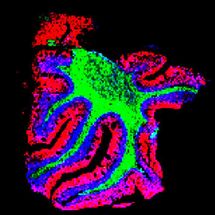Book scorpion venom also effective against hospital germs
The book scorpion (Chelifer cancroides), only a few millimetres long, is the best-known member of the pseudoscorpions, an order of arachnids, in Central Europe. It hunts house dust mites, bark lice and book lice in living spaces. It also kills pests in beehives. It often uses its venom to do so. For the first time, researchers in Hesse, Germany, have comprehensively characterised the components of this venom – and discovered molecules with a strong effect against so-called hospital germs. The results may help to combat difficult-to-treat infectious diseases in the future.
A team of Hessian researchers from the LOEWE Centre for Translational Biodiversity Genomics (LOEWE-TBG) and other institutions has now succeeded for the first time in artificially producing all known members of a family of toxins from the book scorpion (Chelifer cancroides) and investigating their activity. The scientists discovered a surprisingly strong activity against a well-known hospital germ called Methicillin-resistant Staphylococcus aureus (MRSA). Staphylococci are common bacteria that colonise the skin and mucous membranes. What makes MRSA variants special is that they are resistant to the antibiotic methicillin and therefore cause difficult-to-treat infections in humans, including after surgery.
The family of toxins analysed had been newly discovered in a previous study decoding the venom cocktail of the book scorpion and named “checacins”. In order to quickly and efficiently find out more about the mode of action of this previously unknown class of toxins, different working groups from the LOEWE Centre TBG tested the activity of the toxins against tumour formation, bacteria and inflammation in parallel – at the Fraunhofer Institute for Translational Medicine and Pharmacology (ITMP) in Frankfurt, at the Goethe University Frankfurt and at the Fraunhofer Institute for Molecular Biology and Applied Ecology IME, institute branch Bioresources (IME-BR) in Giessen. The study has been published in the journal “iScience”.
Before a pharmacological application is possible, however, there are further hurdles to overcome: “Our data show that the checacins unfortunately also have a certain toxicity for human cells and could possibly cause inflammatory reactions themselves. Therefore, we still need to optimise their structure and thus their effect using biotechnological processes, as is the case with other active substances,” explains the study's co-first author, TBG scientist Dr Pelin Erkoc, who worked at the Institute of Pharmaceutical Biology at Goethe University Frankfurt during the analyses. “However, the potential of these compounds is already clear. It is predicted that antibiotic-resistant infections could become the leading cause of disease-related death worldwide in the coming decades. It is therefore important to look for new solutions with unusual ideas,” adds Dr Michael Marner, postdoctoral researcher at Fraunhofer IME-BR and co-author of the study.
“Animal venoms are a veritable treasure trove of potential drug candidates, but only a small proportion have been investigated so far," emphasises study leader Dr Tim Lüddecke, head of the junior research group Animal Venomics at Fraunhofer IME-BR and Justus Liebig University Giessen and member of the LOEWE Centre TBG. “In my group, we have developed modern systems biology and biotechnological methods to study the very small venomous animals that are difficult to analyse. In particular, we focus on arachnids. They are the master chemists of venomous animals: Their venoms are particularly complex and pharmacologically promising. Our new results on the checacins show how worthwhile it is to take a closer look at the unknown universe of venoms of small creepy-crawlies," Lüddecke concludes.
Original publication
Pelin Erkoc, Susanne Schiffmann, Thomas Ulshöfer, Marina Henke, Michael Marner, Jonas Krämer, Reinhard Predel, Till F. Schäberle, Sabine Hurka, Ludwig Dersch, Andreas Vilcinskas, Robert Fürst, Tim Lüddecke; "Determining the pharmacological potential and biological role of linear pseudoscorpion toxins via functional profiling"; iScience, Volume 27




















































